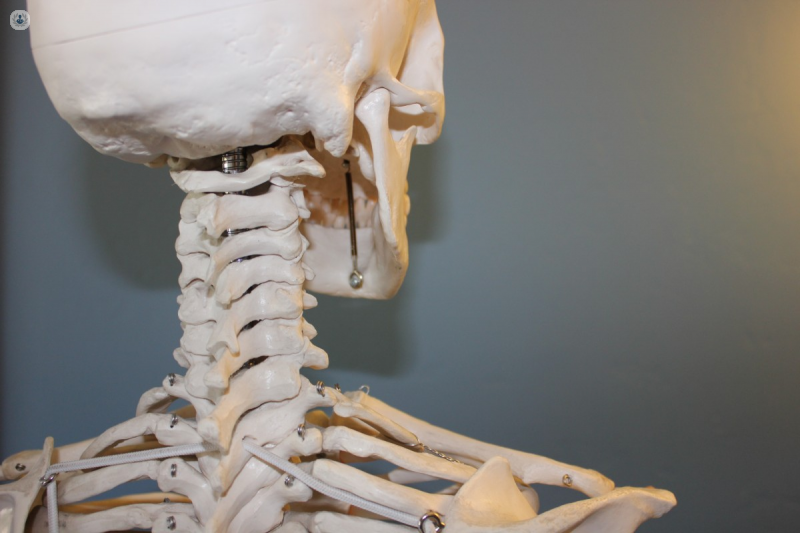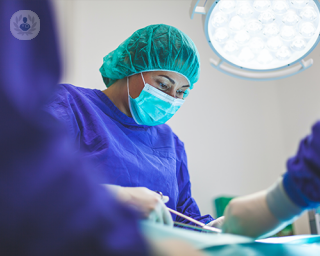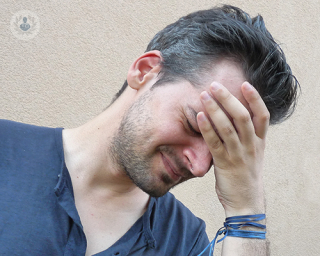Craniocervical junction abnormalities
Mr Shabin Joshi - Neurosurgery
Created on: 11-13-2012
Updated on: 06-02-2023
Edited by: Jay Staniland
What are craniocervical junction abnormalities?
Craniocervical junction abnormalities can be either congenital or acquired abnormalities, they're usually found in the occipital bone, occipital foramen and/or in the first two vertical vertebrae. They can cause serious health problems.
These abnormalities can generate numerous discomforts and problems that hinder the patient's daily life, such as neck pain and syringomyelia as well as deficiencies in the cerebellum or the spinal cord.

Congenital disorders are abnormalities present at the moment of the individual's birth. They can interfere with the growth and development of the skeleton. Some congenital structural alterations would be some of the following:
- Malformation of the odontoid oophosis of the atlas.
- Assimilation of the atlas, with congenital fusion of the atlas and occipital bone
- Klippel-Feil congenital malformation
- Atlas hypoplasia
- Chiari malformations
For their part, the general or systemic disorders that affect the development and growth of the skeleton and the craniocervical junction are the following:
Achondroplasia: a bone growth disorder that causes dwarfism. Normallly cartilage in a baby converts to bone as they grow, in people with achondroplasia a lot of cartilage doesn't convert to bone. Mutations in the FGFR3 gene cause this.
Down's syndrome, Morquio syndrome or osteogenesis imperfecta.
Acquired malformations
There are also acquired malformations. These are injuries that can affect both the bone and the ligaments and are normally due to trauma caused by falls and accidents.
Rheumatoid arthritis is the most frequent pathological cause. This, together with Paget's disease, can cause atlantoaxial dislocation or subluxation, such as metastatic tumours.
Slow-growing craniocervical junction tumours such as meningioma that may touch the brainstem or medulla.
Prognosis of malformations of the craniocervical junction
Craniocervical junction anomalies can be really dangerous in some of their varieties. Early detection can help the patient to reverse various signs and problems arising from the pathology.
In some cases, these malformations can be fatal, so monitoring their condition and progress is essential for a patient's quality of life.
Symptoms of malformations of the craniocervical junction
The symptoms of malformations may appear spontaneously or at the time the patient has suffered a cervical injury, however slight. Symptoms vary depending on the degree of compression and depending on the structures affected.
As a general rule, the patient has pain in the neck, usually accompanied by headache, often in the back of the head.
In the event that there is a spinal compression, the arms and / or legs may show weakness making it difficult to move.
Depending on the disorder, the neck may be short, winged, or turned or tilted in an abnormal position, limiting head movement.
Pressure in certain parts of the brain or on the nerves in the skull can also affect vision and eye movement ability. Thus, blurred vision, inability to control eye movement, limited movements, and the eyes moving involuntarily in different directions, may present.
On the other hand, patients may also have difficulty swallowing, as well as aphonia (a loss of voice), or difficulty speaking, in certain cases.
There are cases in which some patients develop sleep apnoea.
Changing the position of the head can press on arteries, interrupting blood flow, and the patient may lose consciousness or feel light-headed, confused, or weak. The feeling of vertigo is also frequent in these cases.
In those affected by Chiari malformations, a cavity is formed in the marrow called syringomyelia; it can expand and elongate and cause people to lose the ability to feel pain and temperature.
Medical tests for craniocervical malformations
Craniocervical malformations are diagnosed through diagnostic imaging tests. Early diagnosis is important, as immediate treatment can reverse some symptoms and prevent a disability that may end up being permanent.
The specialist will suspect the existence of a pathology or a disorder of the craniocervical union in the following cases:
The patient registers nystagmus, that is, involuntary movements of the eyes
Neck pain or pain in the back of the head
If the initial diagnosis is confirmed by diagnostic imaging tests, such as nuclear magnetic resonance imaging (MRI) or computed tomography (CT). The CT offers better results since it allows the doctor to see the state of the bones better. If the tomography and MRI are not available, it can be diagnosed through x-rays.
In the event that the results of the imaging tests do not provide reliable data, you can choose to do a myelography. In the event that abnormalities in the blood vessels are suspected, the specialist physician will recommend an angiography.
What are the causes of craniocervical abnormality?
Abnormalities or malformations can exist from birth or be acquired over the years.
Birth defects: these are present from the moment the patient is born. There are two types, those that cause isolated disorders — it only affects the craniocervical junction — and the general ones, which also affect other parts of the body.
Isolated disorders include the following:
- Platibasia: the occipital bone is flattened.
- Basilar invagination: there is a malformation in part of the occipital bone. Neck height decreases and presses on parts of the brain, nerves, and medulla.
- Assimilation of the atlas: the occipital bone and the first vertebra (the atlas) are fused.
- Atloaxoid subluxation or dislocation: atlas and axis —the first two bones of the spine— are misaligned.
- Hypoplasia of the atlas: the first vertebra has not fully developed Klippel-Feil malformation: the first two bones of the spine are fused, making it difficult to start the movement.
- Chiari malformation: the cerebellum protrudes through the occipital bone, being able to exert on the brain stem.
- Os osdontoideum: the axis vertebra is replaced by an abnormal bone.
General disorders can cause the same abnormalities as isolated disorders, but within a group of abnormalities:
- Disorders that affect bone formation in children (achondroplasty). They are disorders that affect all developing bones and, especially, the long bones of the arms and legs, which may be too short and malformed, causing dwarfism.
- Down's syndrome, mucopolysaccharidosis and psteogenesis imperfecta
- Acquired defects: in this case, disorders and malformations appear late. They can appear due to illness or trauma. They can affect both bones and ligaments. In most cases, the causes are automobile, bicycle or jumping accidents. In some cases, injuries are immediately fatal.
The most frequent are:
- rheumatoid arthritis
- Paget's disease of bone
It should be noted that tumours can also affect these structures, and in the event that it spreads to the vertebrae, it can press on the brain or spinal cord.
Can craniocervical junction abnormalities be prevented?
There is no way to prevent congenital disabilities or abnormalities entirely. In some cases, the presence of these can be determined before delivery thanks to prenatal testing. If acquired injuries can be prevented in a certain way, such as by using protective equipment when performing dangerous activities such as jumping, climbing, or cycling.
Treatments for craniocervical abnormality
Treatments for these abnormalities focus on realignment, immobilisation, and traction of structures that have been affected. In the event that these structures put pressure on the brain, nerves or medulla, the medical specialist will try to reduce and realign the structures through traction or by changing the position of the head. In the event that realignment is achieved, both head and neck will be immobilised.
However, realignment typically involves the use of traction. Traction involves placing a device that surrounds and is attached to the skull, which is called the halo.
Once realigned, the halo is attached to a kind of vest that adjusts and immobilises the neck. It is used for eight or twelve weeks, and once in place, x-rays are taken to see if everything is correctly aligned.
In the event that traction is not effective, there is a surgical process to relieve compression and stabilise the structures. This is the case for example of rheumatoid arthritis, which will always require surgery that uses metal plates, bars and screws to stabilise the structures in one position until the bones fuse. In the event that a bone tumour generates the disorder, treatment may be radiation therapy and a rigid collar to stabilise the neck.
Which specialist treats abnormalities of the craniocervical junction?
A neurosurgeon is the medical specialist who will be able to detect, diagnose and treat craniocervical junction abnormalities.



